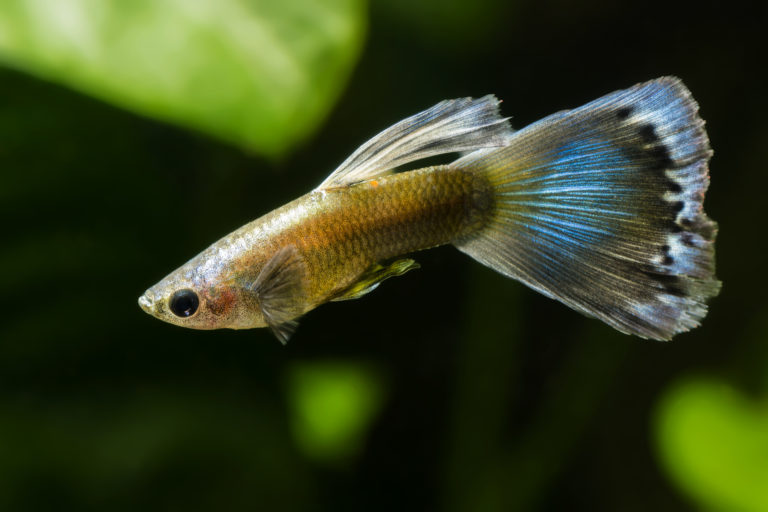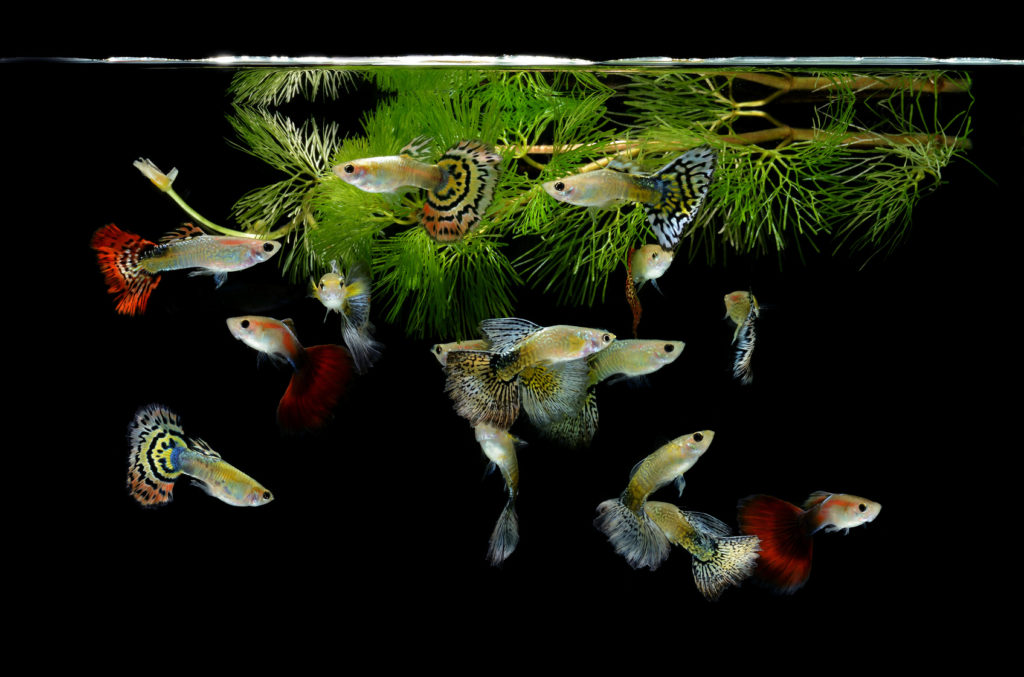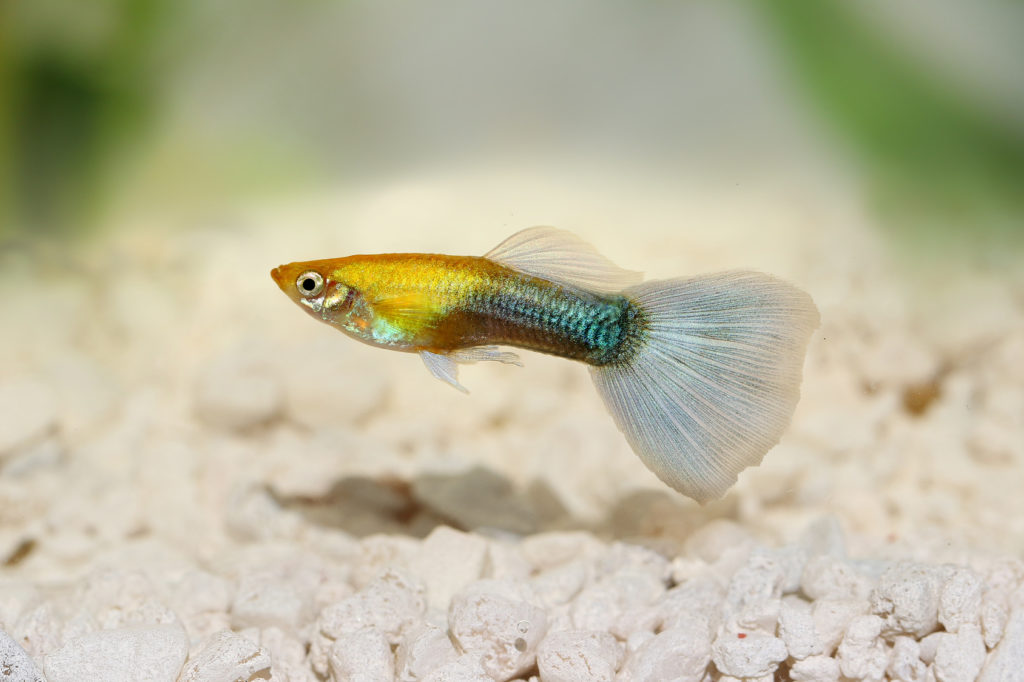Butterfly Koi
Are you looking for new carps (Cyprinus carpio) for your pond? Then you should definitely consider the Butterfly Koi. Read in this article the most important information on this beautiful Koi.
Guppies (Poecilia reticulata) are among the most popular fish for freshwater aquariums worldwide. They breed easily even in captivity, are easy to care for, and thus are well-suited for beginners in aquaristics. Guppies are colourful and forgiving of small mistakes. These active animals come in many varieties.

© lapis2380 / stock.adobe.com
Guppy is ideal for beginners in aquaristics
Guppies are between 3 and 5 cm in length. The females are usually larger and rounder than the males. In aquariums, guppies can live up to five years, whereas in the wild, they rarely reach two years. Guppies are livebearers. The females are relatively plain with white-silver, scaly skin. Male guppies are much more striking. They have an elongated fin and tail fin, which can be tapered, fan-shaped, or spade-shaped. The tail fin comes in numerous shades. The subtypes are named based on their fin shape. Individual specimens can be quite noticeable but bear little resemblance to wild female guppies. The male wild type, however, is colourful and exists in various subtypes.
In 1866, a fish was caught off the coast of Trinidad and sent for classification to the German researcher Albrecht Günther. Since then, its taxonomy has remained unchanged. The names from the discovery period in 1859 are no longer valid. It belongs to the family of bony fish and specifically to the subfamily of livebearing toothcarps (Poeciliidae). They fall under the category of ray-finned fish and the subcategory of newly-finned fish.
Today, many breeds specialise in specific colours and tail shapes. Most types of guppies are distinguished mainly by their tail fin’s form. Both colour and shape can vary within the breed. Crossbreeding is not recommended for breeders, as it usually results in the loss of vibrant colours.
For large-finned guppies, the variations include:
Small-finned guppies include:
The Endler Guppy forms a special group. It is a relatively recent aquarium fish, discovered by Prof. John A. Endler in Venezuela in 1975. It differs in body structure and colour from common guppies. It was recognised as a separate species in 2005 after initially being considered a subgroup. This fish typically features a green colour near the lower tail root and an orange band in front of it. They are easy to care for and thrive in a bright, well-planted tank.
Guppies are not endangered and thus not protected. Due to their rapid reproduction and popularity in aquaristics, they are also called million fish. Guppies have extensive distribution, ranging from the northern Amazon across northern South America and the Lesser Antilles. They inhabit the edges of almost all waters, including the brackish water of river mouths. They avoid deep waters, preferring streams and the banks of rivers. These diurnal fish usually stay in the middle and surface zones of the water.
Guppies are hardy and adapt well to their surroundings. After a few generations, they can even withstand temperatures around 12°C. Due to their resilience and to control mosquito populations, guppies have been introduced in many parts of the world. This was aimed at fighting diseases transmitted by mosquitoes. This beneficial effect is also utilised at thermal springs.
Guppies are omnivores and not very picky about their food. This applies both in the wild and in the aquarium. However, they particularly enjoy floating food.
Live food is excellent for providing all the necessary nutrients. Occasionally, guppies will graze on stones and roots of algae or nibble on delicate plants. They digest their food in about 45 minutes, so aquarium owners should feed them frequently but in small amounts. A fasting day per week is beneficial for their health, relieving the digestive tract and fostering the development of young fish.
Dry Flakes are fed most frequently because they are very easy to handle. With 80% water content, the flakes are very similar to natural food. They also contain the optimal combination of nutrients. Once the pack is opened, the minerals and vitamins break down relatively quickly. The dry food should therefore be used up within three months.
Flakes decompose in water after 40 minutes, granules remains stable in water for at least four hours. Therefore, many owners tend to use granules. Frozen food is also very suitable for feeding, but must not have any frost burn. It must be fed frozen. Live food comes closest to natural behaviour, but is more expensive to obtain. In the wild, guppies hunt small young fish, aquatic insects, mosquito and insect larvae, spiders and animals that have fallen onto the water such as snails and worms. When feeding the aquarium. You should never give more than the group can eat within five minutes.
Every guppy aquarium should have water plants. They stabilise the ecosystem and serve as a retreat. They also form the substrate, a vital food source for young guppies. These plants should be resilient and tolerant of irregular salt additions. It resides in all parts of the aquarium, so each layer should be planted. Dense growth at the aquarium’s base is used predominantly as night-time hiding spots. Floating plants on the water’s surface are also popular hiding spots. Mosses filter toxins from the water. However, excessive plant growth is undesirable as it reduces light penetration. Too much moss can also affect the pH balance.
It thrives without a substrate, but in a decorative aquarium, a layer of sand and gravel looks better. Guppies dislike currents as well as active tank mates. An aquarium should be at least 60 cm long for permanent housing.
Guppies come from warm waters. Thus, their water temperature should not drop below 22°C. Although they adapt well and can survive cold periods, lower temperatures should not be the norm. Optimal temperatures for guppies are between 22°C and 25°C.
 © bluehand / stock.adobe.com
© bluehand / stock.adobe.com
Breeding guppy fry in an aquarium is simple. A 25l tank is sufficient for a brood of 20 fry. Larger broods of 60 or more require a min. 80l tank. Guppies often eat their young, so it’s advisable to keep more females than males. Experts suggest a ratio of three females for every male. Guppies are social animals and enjoy company, so they should be kept in groups of at least five.
Guppies quickly adapt to regular feeding. Therefore, even large aquariums with a few fish are manageable. They gain muscle by moving more in large tanks. They also thrive in confined spaces as long as the water is frequently changed. Fish become sexually mature after about three months. For raising young guppies, larger aquariums are recommended. For temporary housing of new fish, you can use a quarantine tank to minimise infection risks. A smaller quarantine tank allows for better monitoring. Ensure that the tank is covered, especially around the feeding area, as the fish may jump out to escape overcrowding.
Some guppies available on the market may be weakened due to overbreeding. It’s wise to purchase from a specialist retailer. Guppies often struggle with altered water composition initially. The next generation, born into the new water conditions, is usually more resilient.
Some species are susceptible to fish diseases like mouth and fin rot or whitespot disease. Mouth and fin rot is a fungus that severely damages the mouth or fins. Infected fins appear milky and frayed. This often results from infrequent water changes. The water must be cleaned and salted with non-iodised salt. Whitespot disease is caused by parasites. Healthy fish can sometimes overcome this disease without treatment, becoming immune afterwards. Infected fish need not be isolated, as the water is also affected. UV treatments or medications can be used to eliminate the parasites, with therapy lasting two to three weeks and must be followed precisely.
 © Mirko Rosenau / stock.adobe.com
© Mirko Rosenau / stock.adobe.com
Due to their adaptability, guppies can coexist with many other fish. Whether a guppy feels comfortable can be gauged by its breeding activity. The stronger their immune system, the better protected they are against diseases. Achieve this by ensuring an ideal living environment.
You can buy guppies from pet shops or online. Availability varies by supplier. Guppies are easy to care for and thrive in aquariums. They quickly adapt to food and, being diurnal, are easy to observe. Watching their diverse behaviour is interesting, even for children, teaching them about the fish’s behaviours and appearance. Ideally, purchase a group of at least five or six guppies, as they tend to get lonely. Guppies enjoy the company of platys, bristlenose catfish, characins, snails, and shrimp.
Are you looking for new carps (Cyprinus carpio) for your pond? Then you should definitely consider the Butterfly Koi. Read in this article the most important information on this beautiful Koi.
Guppies (Poecilia reticulata) are among the most popular fish for freshwater aquariums worldwide. They breed easily even in captivity, are easy to care for, and thus are well-suited for beginners in aquaristics. Guppies are colourful and forgiving of small mistakes. These active animals come in many varieties.
Radiantly colourful and somewhat aggressive towards other fish and conspecifics: The Siamese Fighting Fish is a remarkable creature that brings a dash of colour to any aquarium. With modest demands, this pet is incredibly easy to care for and very popular with aquaristics beginners. This article compiles the most important information about the Siamese Fighting Fish.